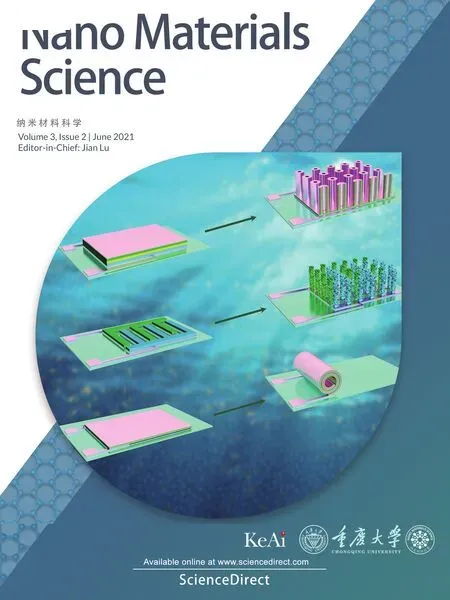Editorial for a special issue“Nano energy materials and devices for miniaturized electronics and smart systems”
The Smart Era urgently demands small-size,low-energy consuming and multi-functional devices which can satisfy versatile application scenarios,including autonomous systems,wireless sensor networks,biomedical equipment,wearable gadgets,and the Internet of Things.This overwhelming trend has drawn much attention and stimulates intensive collaborative efforts spanning diverse fundamental and applied research related to energy generation-harvesting-storage-managementapplications at the small scale.For instance,on one hand,novel nanomaterials and chemical properties need to be developed for efficient energy conversion.On the other hand,advanced micro-/nanofabrication technologies are desired to bring novel strategies for improving areal energy harvesting/storage performance and integration efficiency.In this regard,the review articles presented in this issue cover a broad range of research topics related to miniaturized smart devices,including nano energy system design,thermoelectric materials,battery materials,microbatteries,microsupercapacitors,micro-wind harvesters,and miniaturized memristors[1–7].
M.Zhu et al.provide a perspective on the miniaturized smart system design by taking skin mountable electronics as an example[1].As a promising future application scenario,sophisticated functions,such as sensing,actuating,and computing,are integrated into a soft electronic device that can befirmly mounted to any place of the human body.This perspective discusses the prospects of the development of energy storage devices for the next generation skin mountable electronic devices based on their unique requirements for flexibility and miniaturized size.
B.Meng et al.review the recent progress on n-type polymer thermoelectric(TE)materials[2].TE materials based on conjugated polymers possess great advantages of solution processibility,light weight,flexibility,and low thermal conductivity,compared to inorganic TE materials.Due to inefficient n-doping and unstable electron transport of most n-type conjugated polymers,the TE performance of n-type polymers is much poorer than that of their p-type counterparts.This review focuses on the structure-performance relationships based on promising n-type polymers for TE applications and provides guidelines for future materials design.
J.Zhang et al.review recent developments in binders for lithiumsulfur(Li–S)batteries[3].The Li–S is a promising energy storage system with many advantages over the Li-ion batteries.Apart from the limited usage of the electrode materials,binders affect the discharge capacity and cycling stability of sulfur cathodes in Li–S batteries.In this review,the desirable characteristics of binders are discussed based on the correlation between the functions of the binder molecules and the performance of the batteries.
Y.Li et al.review the recent development of configurations and fabrication technologies of microbatteries[4].Rechargeable microbatteries are important power supplies for microelectronic devices.High output energy and minimal footprint areas are the two essential targets for rechargeable microbatteries.The review article also stresses the potential of rolled-up nanotechnology,a derivative of micro-origami technologies,and discusses the challenges and perspectives of design and materials optimization in these novel devices.
F.Li et al.review recent progress of stamping materials and technologies for microsupercapacitors[5].Stamping micro-supercapacitors(MSCs)with planar interdigital configurations are considered promising candidates for miniaturized energy storage devices.The review summarizes the present merits of materials,manufacturing methods,and their properties of stamping MSCs.Further insights into technical difficulties and scientific challenges of these newly developed MSCs are also discussed.
Q.Wen et al.review the state-of-the-art of miniaturized wind energy harvesters[6].Microscale wind energy harvesters have attracted widespread attention because of their great potential of power density as well as the rich availability of wind energy in many possible application areas,such as the Internet of Things(IoT).The review presents fruitful discussions on crucial factors for the miniaturized wind energy harvesters to achieve high working efficiency and potential energy coupling mechanisms.
N.Du et al.review emerging low-power-consuming memristive technologies for hardware security systems[7].Memristive devices offer enormous advantages for applications such as non-volatile memories,in-memory computing,and hardware security.This review article is helpful to explore security solutions and to develop corresponding protections based on low-power-consuming memristive designs for achieving safer secure hardware in miniaturized smart devices.
In summary,this issue covers several topics related to miniaturized smart devices,including system design of miniaturized energy components,nanomaterials and fabrication technologies for energy storage devices,material designs and device structures for energy generators,and low-energy-consuming memristive devices for realizing“smart”.This special issue expects to provide a broad perspective for readers to grasp the state-of-the-art research achievements in the correspondingfields,and understand their potential and challenges towards the future Smart Era.
Declaration of competing interest
None.
- Namo Materials Science的其它文章
- GUIDE FOR AUTHORS
- Aim & Scope
- Low-power emerging memristive designs towards secure hardware systems for applications in internet of things
- A comprehensive review of miniatured wind energy harvesters
- Recent developments of stamped planar micro-supercapacitors:Materials,fabrication and perspectives
- Advanced architecture designs towards high-performance 3D microbatteries

